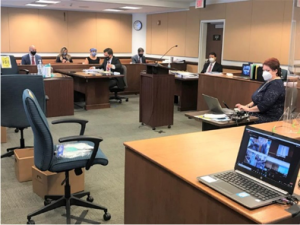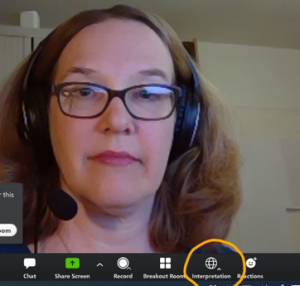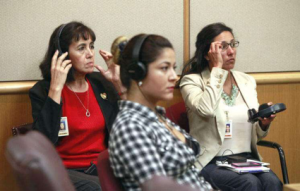 The COVID-19 Pandemic has been both a blessing and a curse for court interpreters in the United States. When the Pandemic began, nearly all court interpreting in the United States shifted from face-to-face in court interpretation to virtual court, changing courtrooms and homes into one of the same. On the one hand, applications such as Zoom have allowed for greater accessibility of interpreters regardless of location and timing. As an example, interpreters needed at the last minute, prior to the pandemic, had to interpret from a speaker phone in the courtroom because it was not possible to bring them in person. Now, through platforms such as Zoom, an interpreter on the other side of the country can see a person who is Limited English Proficient (“LEP”), and the LEP individual can see the interpreter. The Pandemic has certainly ushered court interpreting around the country into the 21st Century. On the other hand, the environment in which the interpreter must interpret and the environment the individual who is LEP is in, has at times strained the quality of virtual court interpretation. Court interpreters that were used to working in the courtroom, now had to work from their homes, dependent on creating a work environment that is adequate to perform interpretations in. The LEP individuals’ environment has also led to similar quality issues. For interpreters and individuals with LEP’s, poor internet connectivity, poor audio output, and a host of other issues can affect the quality and duration of a virtual proceeding using a court interpreter.
The COVID-19 Pandemic has been both a blessing and a curse for court interpreters in the United States. When the Pandemic began, nearly all court interpreting in the United States shifted from face-to-face in court interpretation to virtual court, changing courtrooms and homes into one of the same. On the one hand, applications such as Zoom have allowed for greater accessibility of interpreters regardless of location and timing. As an example, interpreters needed at the last minute, prior to the pandemic, had to interpret from a speaker phone in the courtroom because it was not possible to bring them in person. Now, through platforms such as Zoom, an interpreter on the other side of the country can see a person who is Limited English Proficient (“LEP”), and the LEP individual can see the interpreter. The Pandemic has certainly ushered court interpreting around the country into the 21st Century. On the other hand, the environment in which the interpreter must interpret and the environment the individual who is LEP is in, has at times strained the quality of virtual court interpretation. Court interpreters that were used to working in the courtroom, now had to work from their homes, dependent on creating a work environment that is adequate to perform interpretations in. The LEP individuals’ environment has also led to similar quality issues. For interpreters and individuals with LEP’s, poor internet connectivity, poor audio output, and a host of other issues can affect the quality and duration of a virtual proceeding using a court interpreter.
The positive and negative developments that have come up since the pandemic began has created an interesting paradox. It has become much easier for courts around the country to get a court interpreter, but at the same time, the technological limitations of a virtual courtroom and the technological limitations of the users can cause many headaches. A prime example of this paradox is using simultaneous interpretation in a virtual courtroom. Pre-pandemic, most face-to-face courtroom proceedings that required an interpreter used a technique called simultaneous interpretation, which is where an interpreter translates what is being said in the courtroom right as it is spoken, which allows for large portions of proceedings to go on without interruption. This technique is much more judicially efficient and in contrast to consecutive interpretation, which is where an interpreter would need the court proceedings to pause after every few sentences uttered to give time for the interpreter to interpret. In a pre-pandemic world, when interpreters could be right next to the LEP, they would interpret for them in a lower tone of voice that would allow them to be only heard by the LEP and not disrupt court proceedings, allowing for simultaneous interpretation to be feasible. When individuals with LEP needed to speak, the interpreter would then project their voice to the entire courtroom.
 When proceedings went on to Zoom however, the ability for an interpreter to interpret simultaneously was initially lost. Due to this, consecutive interpretation for a time became the rule for virtual hearings and the duration of hearings where interpreters were needed were at least doubled from hearings that did not need an interpreter. Zoom eventually provided updates, which allowed for simultaneous interpretation to be used via their platform. Normally on a Zoom call, everyone can hear everyone when they speak because they are all on the same audio channel. The simultaneous interpretation function would allow for the LEP person to be in their own audio channel with the court and other parties to the case in another audio channel where the proceeding would be conducted in English. The interpreter can switch between both channels, which would allow for simultaneous interpretation as the court would not hear the interpreter interpreting for the party or parties who needed the interpreter and only hear the interpreter when a response from the LEP person was needed. In practice, simultaneous interpretation can be difficult to implement as all parties have to select the proper audio channel to be in, for the hearing to be done as planned. For some LEP individuals, attorneys, judges, and court staff, who are tech adverse, this creates a situation that would make simultaneous interpretation difficult to execute properly. For courts who know how to take advantage of Zoom’s simultaneous interpretation system and instruct those in their virtual courtrooms how to use it, it can work like a dream. For those who cannot, it is a nightmare that is to be avoided at all costs even at the expense of judicial economy.
When proceedings went on to Zoom however, the ability for an interpreter to interpret simultaneously was initially lost. Due to this, consecutive interpretation for a time became the rule for virtual hearings and the duration of hearings where interpreters were needed were at least doubled from hearings that did not need an interpreter. Zoom eventually provided updates, which allowed for simultaneous interpretation to be used via their platform. Normally on a Zoom call, everyone can hear everyone when they speak because they are all on the same audio channel. The simultaneous interpretation function would allow for the LEP person to be in their own audio channel with the court and other parties to the case in another audio channel where the proceeding would be conducted in English. The interpreter can switch between both channels, which would allow for simultaneous interpretation as the court would not hear the interpreter interpreting for the party or parties who needed the interpreter and only hear the interpreter when a response from the LEP person was needed. In practice, simultaneous interpretation can be difficult to implement as all parties have to select the proper audio channel to be in, for the hearing to be done as planned. For some LEP individuals, attorneys, judges, and court staff, who are tech adverse, this creates a situation that would make simultaneous interpretation difficult to execute properly. For courts who know how to take advantage of Zoom’s simultaneous interpretation system and instruct those in their virtual courtrooms how to use it, it can work like a dream. For those who cannot, it is a nightmare that is to be avoided at all costs even at the expense of judicial economy.
 While courthouses around the country are reopening to conduct in-person proceedings, it is likely that for shorter proceedings, virtual courtrooms are here to stay. This means that the legal system, as tech adverse as it historically is and court interpreters, who are used to interpreting in person, must learn to adapt to this new reality. Five-minute motion calendars on litigation, hearings on traffic infractions, and proceedings on mental capacity, just to name a few, will for the most part remain on a platform like Zoom for the long haul. Thus, court systems around the country that have a great need for court interpreters, will need to further educate their judges and court staff so that they themselves can educate those who login to their virtual courtrooms on what they need to do to better utilize a court interpreter. This will allow for greater judicial economy for judges and court staff in their courtrooms. Education alone will not fix bad internet connections, poor audio quality, and people who may find technology almost alien, but anything that can ease the burden of interpreting virtually on the courts and the interpreters who conduct them will be greatly beneficial and allow for the wheels of justice to roll on as best they can.
While courthouses around the country are reopening to conduct in-person proceedings, it is likely that for shorter proceedings, virtual courtrooms are here to stay. This means that the legal system, as tech adverse as it historically is and court interpreters, who are used to interpreting in person, must learn to adapt to this new reality. Five-minute motion calendars on litigation, hearings on traffic infractions, and proceedings on mental capacity, just to name a few, will for the most part remain on a platform like Zoom for the long haul. Thus, court systems around the country that have a great need for court interpreters, will need to further educate their judges and court staff so that they themselves can educate those who login to their virtual courtrooms on what they need to do to better utilize a court interpreter. This will allow for greater judicial economy for judges and court staff in their courtrooms. Education alone will not fix bad internet connections, poor audio quality, and people who may find technology almost alien, but anything that can ease the burden of interpreting virtually on the courts and the interpreters who conduct them will be greatly beneficial and allow for the wheels of justice to roll on as best they can.



 The COVID-19 Pandemic has been both a blessing and a curse for court interpreters in the United States. When the Pandemic began, nearly all court interpreting in the United States shifted from face-to-face in court interpretation to virtual court, changing courtrooms and homes into one of the same. On the one hand, applications such as Zoom have allowed for greater accessibility of interpreters regardless of location and timing. As an example, interpreters needed at the last minute, prior to the pandemic, had to interpret from a speaker phone in the courtroom because it was not possible to bring them in person. Now, through platforms such as Zoom, an interpreter on the other side of the country can see a person who is Limited English Proficient (“LEP”), and the LEP individual can see the interpreter. The Pandemic has certainly ushered court interpreting around the country into the 21st Century. On the other hand, the
The COVID-19 Pandemic has been both a blessing and a curse for court interpreters in the United States. When the Pandemic began, nearly all court interpreting in the United States shifted from face-to-face in court interpretation to virtual court, changing courtrooms and homes into one of the same. On the one hand, applications such as Zoom have allowed for greater accessibility of interpreters regardless of location and timing. As an example, interpreters needed at the last minute, prior to the pandemic, had to interpret from a speaker phone in the courtroom because it was not possible to bring them in person. Now, through platforms such as Zoom, an interpreter on the other side of the country can see a person who is Limited English Proficient (“LEP”), and the LEP individual can see the interpreter. The Pandemic has certainly ushered court interpreting around the country into the 21st Century. On the other hand, the  When proceedings went on to Zoom however, the ability for an interpreter to interpret simultaneously was initially lost. Due to this, consecutive interpretation for a time became the rule for virtual hearings and the duration of hearings where interpreters were needed were at least doubled from hearings that did not need an interpreter. Zoom eventually provided
When proceedings went on to Zoom however, the ability for an interpreter to interpret simultaneously was initially lost. Due to this, consecutive interpretation for a time became the rule for virtual hearings and the duration of hearings where interpreters were needed were at least doubled from hearings that did not need an interpreter. Zoom eventually provided  While courthouses around the country are reopening to conduct in-person proceedings, it is likely that for shorter proceedings, virtual courtrooms are here to stay. This means that the legal system, as tech adverse as it historically is and court interpreters, who are used to interpreting in person, must learn to adapt to this new reality. Five-minute motion calendars on litigation, hearings on traffic infractions, and proceedings on mental capacity, just to name a few, will for the most part remain on a platform like Zoom for the long haul. Thus, court systems around the country that have a great need for court interpreters, will need to further educate their judges and court staff so that they themselves can educate those who login to their virtual courtrooms on what they need to do to better utilize a court interpreter. This will allow for greater judicial economy for judges and court staff in their courtrooms. Education alone will not fix bad internet connections, poor audio quality, and people who may find technology almost alien, but anything that can ease the burden of interpreting virtually on the courts and the interpreters who conduct them will be greatly beneficial and allow for the wheels of justice to roll on as best they can.
While courthouses around the country are reopening to conduct in-person proceedings, it is likely that for shorter proceedings, virtual courtrooms are here to stay. This means that the legal system, as tech adverse as it historically is and court interpreters, who are used to interpreting in person, must learn to adapt to this new reality. Five-minute motion calendars on litigation, hearings on traffic infractions, and proceedings on mental capacity, just to name a few, will for the most part remain on a platform like Zoom for the long haul. Thus, court systems around the country that have a great need for court interpreters, will need to further educate their judges and court staff so that they themselves can educate those who login to their virtual courtrooms on what they need to do to better utilize a court interpreter. This will allow for greater judicial economy for judges and court staff in their courtrooms. Education alone will not fix bad internet connections, poor audio quality, and people who may find technology almost alien, but anything that can ease the burden of interpreting virtually on the courts and the interpreters who conduct them will be greatly beneficial and allow for the wheels of justice to roll on as best they can.